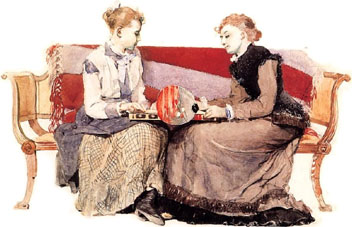|
| Magriel's NYT Columns |
 The most difficult and exciting games in backgammon occur when both sides have men blockaded behind each other’s prime. Such “prime vs. prime positions are extremely volatile — a single roll or play often decides the outcome. For this reason, careful evaluation of competing game plans and accurate tactical play are never more important.
The most difficult and exciting games in backgammon occur when both sides have men blockaded behind each other’s prime. Such “prime vs. prime positions are extremely volatile — a single roll or play often decides the outcome. For this reason, careful evaluation of competing game plans and accurate tactical play are never more important.
The game shown in the diagrammed position has reached a critical stage. Black appears to be at a disadvantage because he has two men trapped behind White’s five-point prime (from the 22- to the 18-point) whereas White has only a single man (on the bar) behind Black’s five-point prime (from the 3- to the 7-point).
Furthermore, White is in no immediate danger of breaking his prime because he has spare men to play with in the outfield. Black, on the other hand, is short of time — unless he soon rolls a 6 with which to leap White’s prime, he will be forced to move forward and break up his home-board position. Nevertheless, Black has some compensation, because if he does roll the needed 6 he will not only leap White’s prime but also hit White’s exposed man on the 17-point.
|
| Black to play 2-1. |
The correct play with the 1 is 3/2. Black’s first priority is to keep White on the bar — Black cannot afford to play 24/23, and so leave a man open on the 2-point. If White reenters and hits this man, Black, with three men back, will have almost no chance to win. Indeed, Black is likely to be gammoned. Playing 24/23 is not nearly as urgent as making the 2-point. Black must attempt to keep White out long enough to roll a 6 and hit a second man of White’s. If he is able to do this, he should then have sufficient time to roll another 1 to move up to the edge of White’s prime.
Many players will focus their attention on the play of the 1 and reach the right decision, 3/2, but then neglect to carefully consider the 2. Indeed, the play of the 2 seems routine — 6/4, maintaining Black’s full prime. However, here’s where the expert will see an opportunity for a subtle alternative.
The correct play is 3/2, 7/5, using the 2 to move a man to the 5-point and so voluntarily break the prime.
|
|
|
Furthermore, note that the risk of White’s rolling an immediate 1-6 must be completely discounted — 1-6 will win for White in any case, because White can always reenter and play 11/17 to form a winning prime.
Rollout
 Tom Keith 2013 |
|
Money play Centered cube Black rolls 2-1 1296 games with VR Checker play: 2-ply Cube play: 3-ply Red |
| 2-1: | Game | G | BG | Equity | ||||
| 1 | 7/5, 3/2 |
W L |
.3956 .6044 |
.2578 .1460 |
.0073 .0065 | −0.1860 |

| (b) |
| 2 | 6/4, 3/2 |
W L |
.3796 .6204 |
.2385 .1472 |
.0070 .0073 | −0.2574 | (0.0714) | (a) |

|
|

